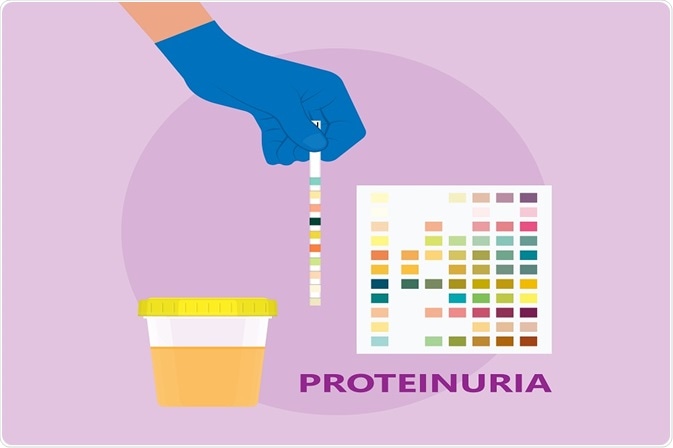Proteinuria, also sometimes referred to as albuminuria or urine albumin is a health condition characterized by an abnormal concentration of protein in the urine.
 Image Credit: rumruay/Shutterstock.com
Image Credit: rumruay/Shutterstock.com
Normal Kidney Function
The kidneys continuously filter the blood as it circulates the body to excrete waste products in the urine and retain important substances such as proteins in the blood.
Most proteins are too large to pass through the glomerular membrane and into the kidneys for filtration and, therefore, remain in the blood. However, proteins may cross this barrier in some cases, particularly if there is damage to the glomeruli.
Proteinuria Causes
Proteinuria can occur as a result of a variety of causes such as diabetes, hypertension, or other systemic diseases that may cause kidney inflammation. Therefore, proteinuria is an important consideration in the diagnosis of many health conditions and is included as a component of a routine medical assessment.
Some individuals are also at an increased risk of being affected by proteinuria. This includes people of African American, American Indian, Hispanic, or Pacific Island origins.
Signs and Symptoms
There are no characteristic signs or symptoms of proteinuria in the early stages of the disease. In fact, many individuals diagnosed with proteinuria do not report any symptoms, and the results are found as a part of routine health checks.
In more severe cases with a larger concentration of protein, the urine may have a more foamy appearance than normal and there may also be other associated symptoms such as edema. Some patients may report symptoms linked to underlying health conditions, such as hypertension or diabetes.
However, the only way to confirm proteinuria is with diagnostic tests such as the urine dipstick test of the 24-hour urine collection test.
Diagnostic Tests
The primary test used to confirm the diagnosis of proteinuria is the 24-hour urine collection test. This involves the collection of all urine excreted within a 24-hour period into sample containers. The samples should be kept in a cool environment and are sent to a laboratory for analysis at the conclusion of the collection period. The amount of protein present in the urine sample excreted over 24-hours is used to diagnose the condition. More than 2 g of protein is considered to be severe and is likely to be caused by a glomerular malfunction.
A single urine sample can also be used to diagnose proteinuria, which is often more convenient than the 24-hour test. This technique compares the concentration of albumin protein to the concentration of creatinine in the urine. As the creatinine concentration is usually constant and a good indication of overall renal function, the protein: creatinine ratio is a useful diagnostic indicator. A ratio of 30 mg of albumin to 1 g of creatinine more is a warning sign of proteinuria.
If results indicate proteinuria, it is important that the potential cause of the protein in the urine is established, which may involve other diagnostic tests. This is important to treat the underlying cause and control the condition.
Management
The primary aim of treatment for proteinuria is to identify and manage the underlying causes.
For example, if the individual has diabetes that is likely to have caused proteinuria, the first step in the management should be to control the blood glucose levels. Likewise, if hypertension is the likely cause, the blood pressure should be lowered with appropriate lifestyle and pharmacological techniques.
Proteinuria: what is it, and what causes it?
References
- https://www.niddk.nih.gov/health-information/kidney-disease
-
Proteinuria: Practice Essentials, Pathophysiology, Etiology (2021). Available at: https://emedicine.medscape.com/article/238158-overview#showall (Accessed: 9 September 2021).
-
Specialist, F. et al. (2021) What is Proteinuria? – NephCure Kidney International ®, Nephcure.org. Available at: https://nephcure.org/livingwithkidneydisease/proteinuria-resource-center/what-is-proteinuria/ (Accessed: 9 September 2021).
-
MBE, D. (2021) Proteinuria | Causes, Tests and Treatment, Patient.info. Available at: https://patient.info/kidney-urinary-tract/chronic-kidney-disease-leaflet/proteinuria (Accessed: 9 September 2021).
-
Naderi, A. and Reilly, R. (2008) "Primary Care Approach to Proteinuria", The Journal of the American Board of Family Medicine, 21(6), pp. 569-574. doi: 10.3122/jabfm.2008.06.070080.
Further Reading